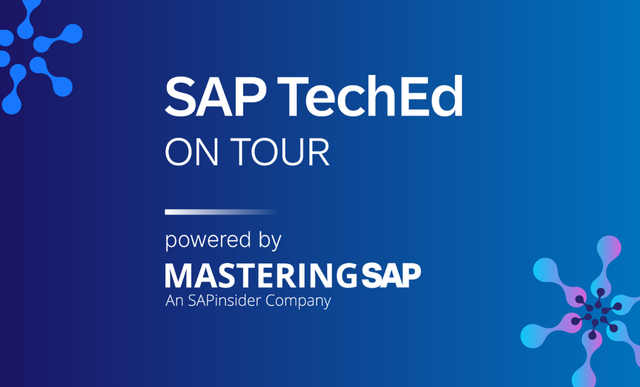SAP ECC Migration
Filter By
Browse By
- SAP Analytics and AI
- SAP Application Development and Integration
- All SAP Application Development and Integration
- SAP ABAP
- SAP ABAP Development Tools
- SAP ABAP Test Cockpit
- SAP API Management
- SAP BAPI
- SAP Basis
- SAP BRF
- SAP Business Application Studio
- SAP CMS
- SAP Design Studio
- SAP Development Tools
- SAP DevOps
- SAP EAI
- SAP EDI
- SAP Extension Suite
- SAP Fiori
- SAP Fiori Elements
- SAP Integration Suite
- SAP Low Code Application Development
- SAP Low Code Automation
- SAP Netweaver
- SAP Release Management
- SAP UI5
- SAP Web Application Server
- SAP Web IDE
- SAP Business Process Management
- SAP Center of Excellence
- SAP CIO
- SAP Customer Experience
- SAP Data and Data Management
- All SAP Data and Data Management
- SAP BW
- SAP BW/4HANA
- SAP Crystal Reporting
- SAP Data Archiving
- SAP Data Center
- SAP Data Governance
- SAP Data Integration
- SAP Data Migration
- SAP Data Quality
- SAP Data Services
- SAP Data Strategy
- SAP Data Visualization
- SAP Data Warehouse Cloud
- SAP DMS
- SAP Document Control
- SAP EIM
- SAP ETL
- SAP ETL Tools
- SAP HANA
- SAP HANA Administration
- SAP HANA Deployment Infrastructure
- SAP HANA Studio
- SAP Master Data
- SAP Master Data Governance
- SAP MDM
- SAP Enterprise Architect
- SAP Enterprise Asset Management
- SAP ERP
- SAP Finance
- All SAP Finance
- SAP Accounting
- SAP AR AP
- SAP Asset Accounting
- SAP Billing Systems
- SAP BPC
- SAP BRIM
- SAP Cash Management
- SAP Central Finance
- SAP Controlling
- SAP COPA
- SAP Cost Center Accounting
- SAP e-invoicing
- SAP FICO
- SAP Finance Automation
- SAP Financial Closing Cockpit
- SAP Financial Consolidation
- SAP Financial Planning
- SAP FX Risk
- SAP General Ledger
- SAP Global Tax Management
- SAP Hyperion
- SAP Order to Cash
- SAP Payment Processing
- SAP Profitability Analysis
- SAP Rebate Management
- SAP S/4HANA Finance
- SAP Universal Journal
- SAP Governance Risk and Compliance
- SAP Human Capital Management
- SAP Intelligent Technologies
- SAP Platform and Technology
- All SAP Platform and Technology
- SAP Business Technology Platform
- SAP Cloud Connector
- SAP Cloud Integration Platform
- SAP Cloud Migration
- SAP Cloud Platform
- SAP Cloud Providers
- SAP Cloud Strategy
- SAP Container Platform
- SAP Digital Asset Management
- SAP Digital Integration Hub
- SAP Digital Signature
- SAP HANA Enterprise Cloud
- SAP HEC
- SAP Hyperscalers
- SAP Infrastructure
- SAP Messaging
- SAP Smart Forms
- SAP Quality and Testing
- SAP Security
- SAP Spend Management
- SAP Supply Chain Management
- All SAP Supply Chain Management
- SAP APO
- SAP Asset Management
- SAP Business Network
- SAP Digital Manufacturing Cloud
- SAP Digital Twin
- SAP EWM
- SAP IBP
- SAP Inventory Management
- SAP Label Printing
- SAP Logistics
- SAP Manufacturing
- SAP Manufacturing Automation
- SAP MES
- SAP MII
- SAP MM
- SAP MRO
- SAP MRP
- SAP Order Management
- SAP Plant Maintenance
- SAP PLM
- SAP Production Planning
- SAP S&OP
- SAP SD
- SAP SPM
- SAP Supply Chain Planning
- SAP Track and Trace
- SAP Transportation Management
- SAP System Administration
What is SAP ECC Migration?
Following the release of SAP S/4HANA in 2015, SAP initially announced that mainstream maintenance for SAP Business Suite 7 and core applications, such as SAP ECC, would end in 2025. In February of 2020 this was extended to 2027. Organizations will have the option to purchase extended maintenance until the end of 2030. This means that organizations running these solutions will need to move to SAP S/4HANA from their existing SAP ERP systems.
What is SAP ECC Migration?
Following the release of SAP S/4HANA in 2015, SAP initially announced that mainstream maintenance for SAP Business Suite 7 and core applications, such as SAP ECC, would end in 2025. In February of 2020 this was extended to 2027. Organizations will have the option to purchase extended maintenance until the end of 2030. This means that organizations running these solutions will need to move to SAP S/4HANA from their existing SAP ERP systems.
SAP ECC migration involves evaluating an organization’s existing systems to see whether they are ready for the move to a new system, acquiring licenses for new software, converting data to the requirements for the new system, determining a deployment model, sourcing infrastructure, and determining whether you will make the move yourself or whether external resources are required. These all represent decisions that need to be made before any SAP ECC migration occurs.
Key Considerations for SAPinsiders:
- An ECC migration can be challenging, so what do you need to do to make the move successful? In talking with SAP Mentor Tammy Powlas, SAPinsider received some recommendations that can make any migration successful. Testing is an integral part of the migration. Prepare and cleanse your data before you move using the checklists that SAP provides in order to make sense. Make sure your third-party tools are SAP S/4HANA compliant. Perform at least a couple of dry runs or sandbox systems to work out kinks before the final go live. You can see the full interview here.
- Listen to what other customers have to say about their SAP ECC migration, and what they were and were not prepared for. SAPinsider has talked to many customers about their move from SAP ECC, and this conversation with Fairfax Water, Newport News Shipyard, and Dow Jones covered several different topics around their environments, the deployment models they used, testing approaches, security challenges, and plans for future upgrades. All these and more are topics that need to be considered for the migration.
- Evaluating and preparing your customized code for migration can be a significant step, but there are ways of making sure you’re ready. Most SAP ECC systems contain customized ABAP code. To perform an SAP ECC migration involves evaluating and determining what part of that code is still needed, and whether it is even still applicable given the underlying data structure changes in SAP S/4HANA. This presentation walks though migrating legacy ABAP code into a new system and highlights challenges along the way, tools that are available to help make the transition easier, and how you can get your development team up to speed for the future.
1300 results
-

Generate Your Cash Flow Report Automatically Using SAP ECC and SAP BusinessObjects Planning and Consolidation
Published: 03/February/2011
Reading time: 23 mins
The cash flow and shareholders’ equity reports are two of the most challenging reports in any legal consolidation project. Generating them on a monthly basis is even more difficult if the right configuration or design is not in place. Follow a real-world procedure used to generate and calculate the statement of cash flows and shareholders’...…
-

All About SAP CRM Tax Configuration
Published: 12/April/2012
Reading time: 17 mins
Understand how to configure SAP CRM tax settings and integrate them with SAP ERP Central Component, financial accounting, managerial accounting, and sales and distribution settings. Key Concept In sales or service processing, the determination of taxes plays a vital role. In the majority of the cases in which an SAP ERP Central Component (SAP ECC)...…
-

How to Integrate Warehouse Processes with SAP TM for a Shipper Scenario
Published: 27/January/2016
Reading time: 36 mins
Learn how to set up the integration between SAP Transportation Management (SAP TM), SAP ERP Central Component (ECC), and SAP Extended Warehouse Management (EWM). When a customer places an order to transport a product with pickup from a warehouse, end-to-end process integration between warehouse operations and execution, transportation planning, and the freight settlement (based on...…
-
-

6 Solutions to SAP S/4HANA Migration Challenges
Published: 28/July/2020
Reading time: 10 mins
Digital transformation is the process of undergoing multiple changes—internal and external—and leveraging digital technologies to become more agile, optimized, and efficient. In order to keep pace with digital transformation, organizations must adopt modernized IT such as SAP S/4HANA—a significant investment that requires preparation. This article reveals six challenges that may prevent businesses from moving forward…
-

Make SAP General Ledger Migration Cockpit More Flexible by Adding Your Own Activities
Published: 23/September/2009
Reading time: 8 mins
Fine-tune the migration cockpit to include your own activities in addition to standard ones so that you can see all the steps in one central place. Key Concept The migration cockpit helps you perform the tasks for migration to the SAP General Ledger. It is a step-by-step guide with all the required steps and the...…
-

Custom Developments for FERC-Compliant Financials Reporting Using SAP HANA and SAP EPM 10
Published: 08/May/2014
Reading time: 31 mins
Financials Follow the stages of the development of a real-life custom solution developed for financial reporting within the oil and mining, utilities, and electric and gas distribution industry in the United States. Compare this improved solution with the same processes executed in SAP ERP Central Component (ECC) Managerial Accounting (CO) and Financial Accounting (FI) modules....…
-

How to Optimize Your Migration to SAP SuccessFactors Employee Central: Live Q&A with Ari Levin
Published: 01/January/2017
Reading time: 37 mins
Conversion and migration to SuccessFactors Employee Central can be a complex and costly activity. In this session, HR 2017 speaker Ari Levin shared insights in the migration to SAP SuccessFactors Employee Central. Learn what factors your organization needs to consider when moving from your on-premise SAP ERP HCM to SAP SuccessFactors Employee Central. Live Blog…
-
-

What you need to know about SAP ERP and APO data transfer using CIF: Q&A with SCM 2014 speaker Claudio Gonzalez
Published: 01/March/2014
Reading time: 29 mins
Thank you everyone who joined us for our Q&A with SCM 2014 speaker Claudio Gonzalez of SCM Connections. Claudio answered reader questions on troubleshooting SAP ERP and APO data transfer with the CIF (core interface). Questions for Claudio included: If we CIF subcontracting SNP PDS, will it create any transportation lanes in APO? When should we use inbound queues…
-

Meet Demand-Driven Scheduling Requirements with SAP ERP and SAP APO: Q&A on When to Use Which for Enhanced Supply and Production Planning
Published: 01/May/2016
Reading time: 31 mins
SAP ERP and the production planning and detailed scheduling (PP/DS) and supply network planning (SNP) components of SAP Advanced Planning and Optimization (SAP APO) offer functionality that can be utilized in a variety of design options to optimize production plans and provide greater visibility into your inventory management, but when do you use which? Especially…
-

Create Consignment Fill-Up Sales Orders Using SAP APO SNP
Published: 20/January/2016
Reading time: 28 mins
Follow these prerequisite, configuration, and implementation steps to model the automatic creation of consignment fill-up sales orders in SAP ERP Central Component (ECC) using Supply Network Planning (SNP) deployment functionality in SAP Advanced Planning and Optimization (SAP APO). This process enables the automatic planning and creation of sales orders from SAP APO. It minimizes the...…
Featured Experts
-

Akash Kumar
Associate General Manager, HCL
-

Become a Member
Unlimited access to thousands of resources for SAP-specific expertise that can only be found here.
Upcoming Events
-

SAP TechEd on Tour, powered by Mastering SAP
November 12 - 14, 2025
Sydney, New South Wales
Australia
View Event
Related Vendors
Your request has been successfully sent

